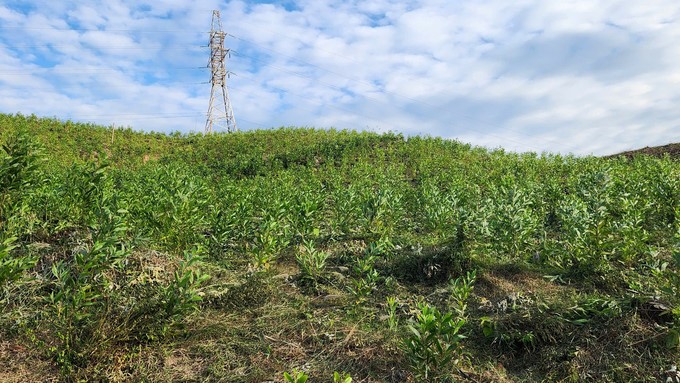November 24, 2025 | 14:59 GMT +7
November 24, 2025 | 14:59 GMT +7
Hotline: 0913.378.918
November 24, 2025 | 14:59 GMT +7
Hotline: 0913.378.918

In the first 2 months of the year, Quang Ninh has newly planted approximately 1,300 ha of forests. Photo: Nguyen Thanh.
Due to the influence of Typhoon No. 3, Ba Che Quang Ninh Forestry One Member Co., Ltd. suffered about 3,500 ha of planted forests.
According to Mr. Chiu Van Quynh, Deputy Director of the Company, in 2025, the unit is expected to newly plant 400 ha of forests. "In order to newly plant the entire 3,500 ha of damaged forest area, the need for seedlings is very large, around 14 million trees. Our company can self-produce about 8 million seedlings; the rest of the company is bought from the outside source," Mr. Quynh said.
According to the Quang Ninh Department of Agriculture and Environment, the density of afforestation with indigenous trees and large timber trees currently ranges from 500 to 1,100 trees/ha. With nearly 32,000 ha of concentrated afforestation in 2025, the whole province needs about 35 million forestry seedlings of all kinds.
According to statistics, there are now 144 nurseries in Quang Ninh, of which 41 facilities have been registered for business and 103 facilities are small and scattered nurseries of households and individuals with the total capacity of forestry seedling production reaching 106.7 million trees/year, including acacia, cinnamon, pine, and indigenous species to serve the needs of afforestation in the province.
Typhoon No. 3 (Typhoon Yagi in September 2024) caused the Quang Ninh forestry industry to be severely damaged, and the whole province's forest coverage decreased by 15% compared to the time before the typhoon (from 55% to 40%). In order to improve the quality of planted forests, the supply of forestry seed sources has also received early attention from Quang Ninh to serve the province's needs of planting and developing forests.
Ms. Ngo Thi Nguyet, Deputy Director of the Quang Ninh Center for Agro-Forestry Science and Production, said that compared to the annual plan, this year's plan to order forestry seedlings is expected to increase by about 50% because the facilities and forestry households in the province have been severely damaged by the typhoon.
Accordingly, units and forestry households focus on rebuilding production, so the demand for seedlings also increased sharply. The Center focuses on all resources to produce seedlings from the laboratory until the nursery.

Ms. Ngo Thi Nguyet introduced forestry seedlings produced by the Center. Photo: Nguyen Thanh.
"According to the process, producing acacia seedlings takes 40 days, and eucalyptus takes 30 days. Therefore, along with focusing on production, we also reduce all costs to lower the price for farmers compared to the current selling price on the market," said Ms. Nguyet. In 2025, the unit produces 2.5–3 million tissue-cultured trees in the laboratory, of which about 1.5 million are taken to the garden. The rest is exported as seedlings to the nurseries.
With a sharp increase in the demand for forestry seedlings, the source of seedlings produced in the province fully meets the afforestation needs of organizations and individuals in the province. In the first 2 months of this year, the whole province's concentrated afforestation area reached approximately 1,300 ha, including more than 42 ha of protection forests and over 1,200 ha of production forests. The area of large timber forest planting, including ironwood, Michelia, and Chukrasia, reached about 35 ha.
The representative of the Quang Ninh Provincial Forest Protection Sub-Department said that in order to raise the forest coverage, the unit directed the Forest Protection Departments to chair and coordinate with district-level divisions and commune People's Committees to strengthen the state management of forestry seedlings.
Strengthen inspection and control of seedling trading activities that increase prices suddenly and unreasonably, and take advantage of the highly increasing demand for seeds and materials for afforestation after the typhoon. At the same time, strictly handle violations of the management of forestry seedlings to control the quality of seedlings and serve the forestry development of the province.
Mr. Nghiem Xuan Cuong, Vice Chairman of the Quang Ninh Provincial People's Committee, also noted a number of tasks for sustainable forestry development in 2025. To be more specific, it is necessary to balance harmoniously between large timber forest planting and production forest planting under the motto of "short-term plan for long-term plan" and promote the economy under the forest canopy associated with ecotourism. Supply forestry seedlings that ensure origin and quality; promote the application of science and technology into afforestation and forestry development.
Absolutely not subjective, neglected, or psychologically surrendered in forest protection and forest fire prevention and fighting. Urgently complete the arrangement, innovation, development, and improvement of operational efficiency of agroforestry companies, specialized agencies, and advisory agencies on forestry activities in the area.
Translated by Thu Huyen
/2025/11/22/4018-4-213342_747.jpg)
(VAN) The Mekong Delta Agricultural Experts Club has attracted 143 experts and researchers to participate in providing consultancy and contributing initiatives to the development of one million hectares of high-quality rice.

(VAN) Ca Mau’s development of OCOP products opens a path to increasing cooperatives value, helping boost income, expand markets, and affirm collective economy's role.

(VAN) Turning seemingly ordinary coconut shells into unique jewelry and artwork, Nguyen Bang Nhi spreads the value of local culture through her brand, Cocohand.

(VAN) Results from the Sustainable Durian Model Project in Dak Lak have confirmed the critical role of Yara Viet Nam in transferring advanced nutritional solutions to farmers.

(VAN) In Tuyen Quang province, livestock farmers have introduced effective models and innovative practices that significantly strengthen African Swine Fever prevention and control efforts.

(VAN) This is the study conducted by IRRI and Can Tho University on the rice straw value chain in Mekong Delta showing an economic potential of more than 6.6 trillion VND/year.

(VAN) By participating in cooperative economics, many farmers in Tay Ninh have overcome hardship, mastered clean dragon fruit cultivation techniques.